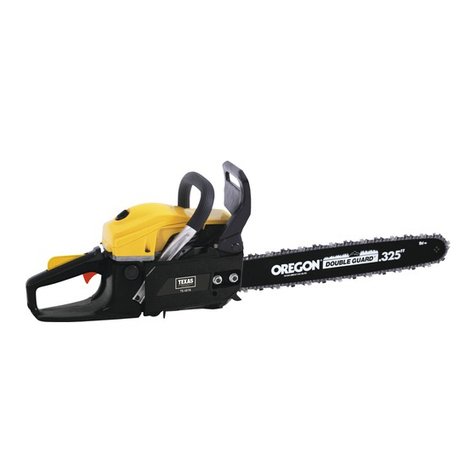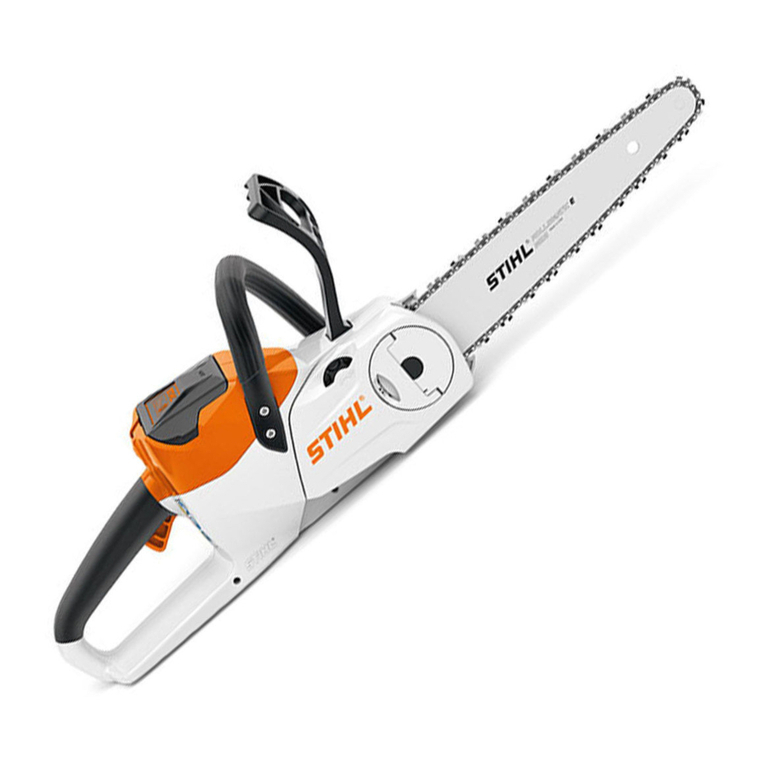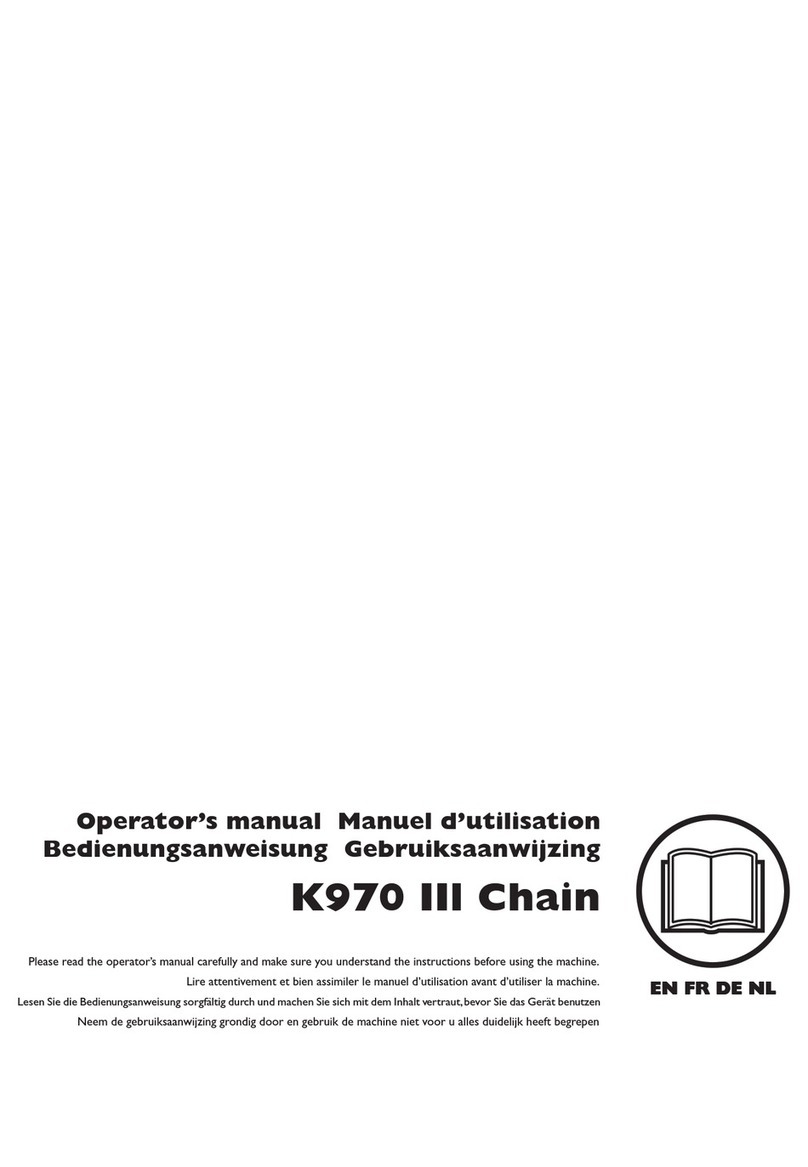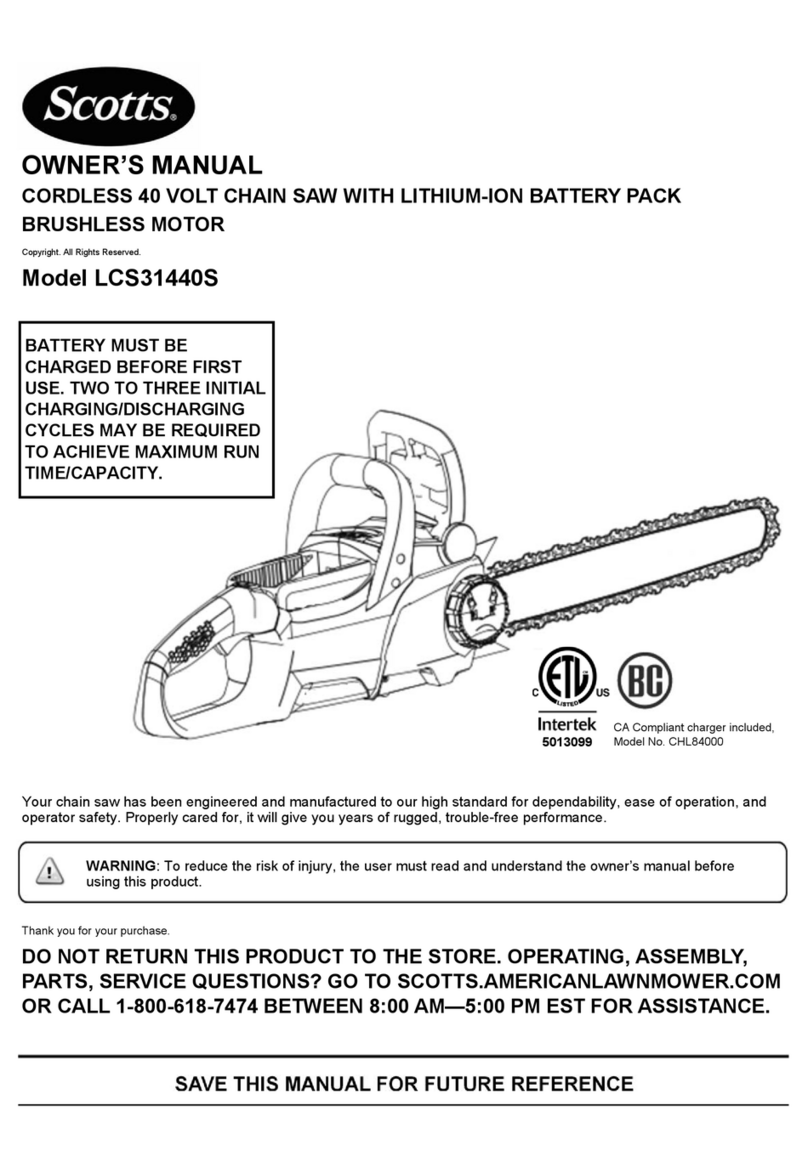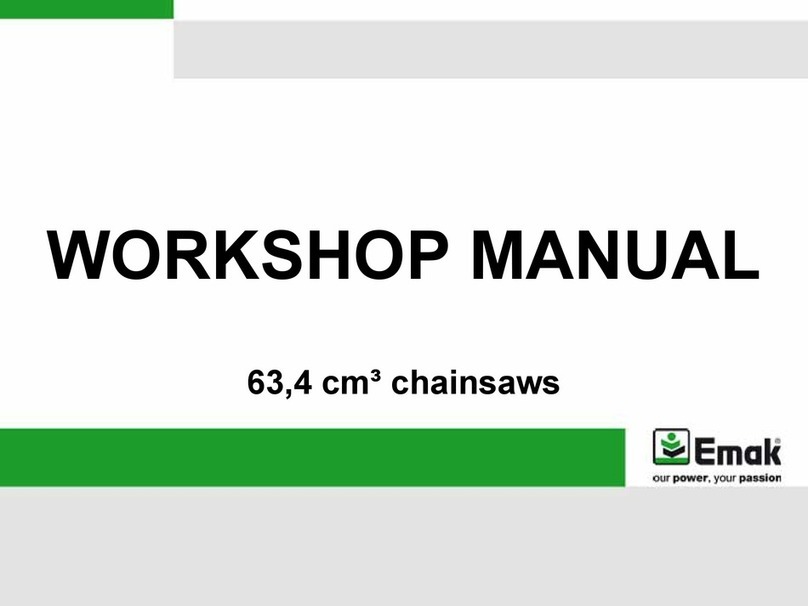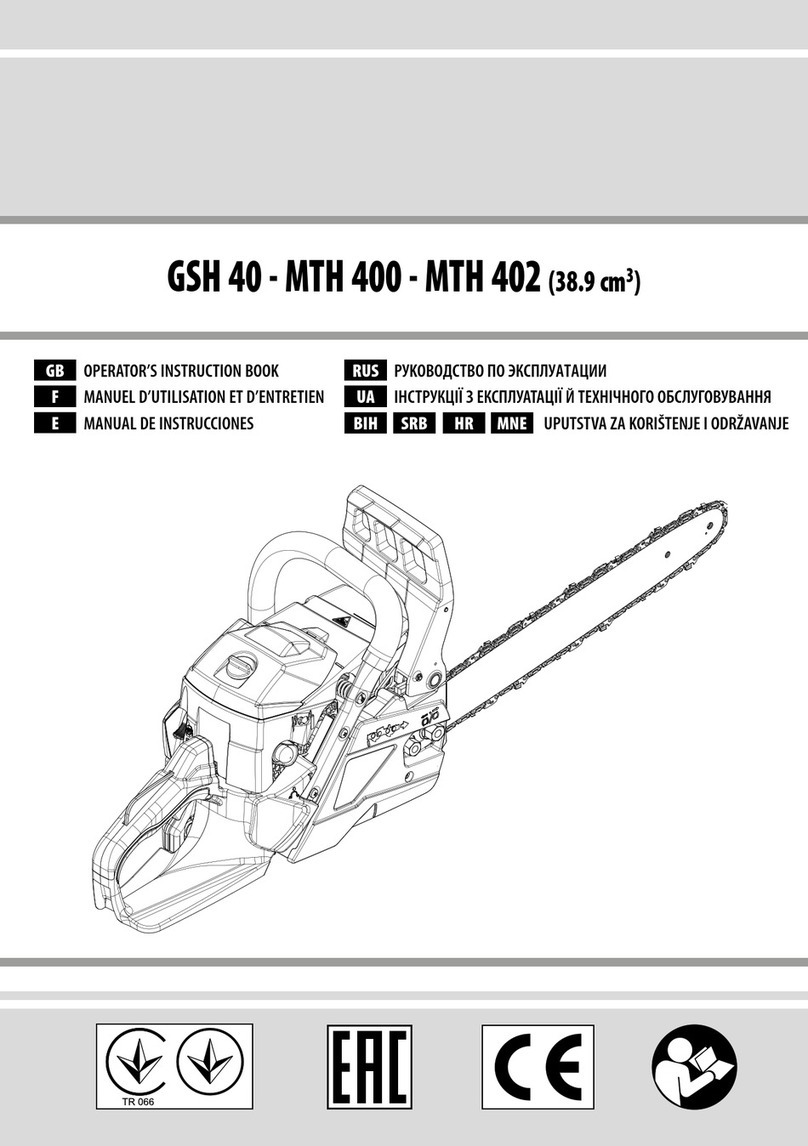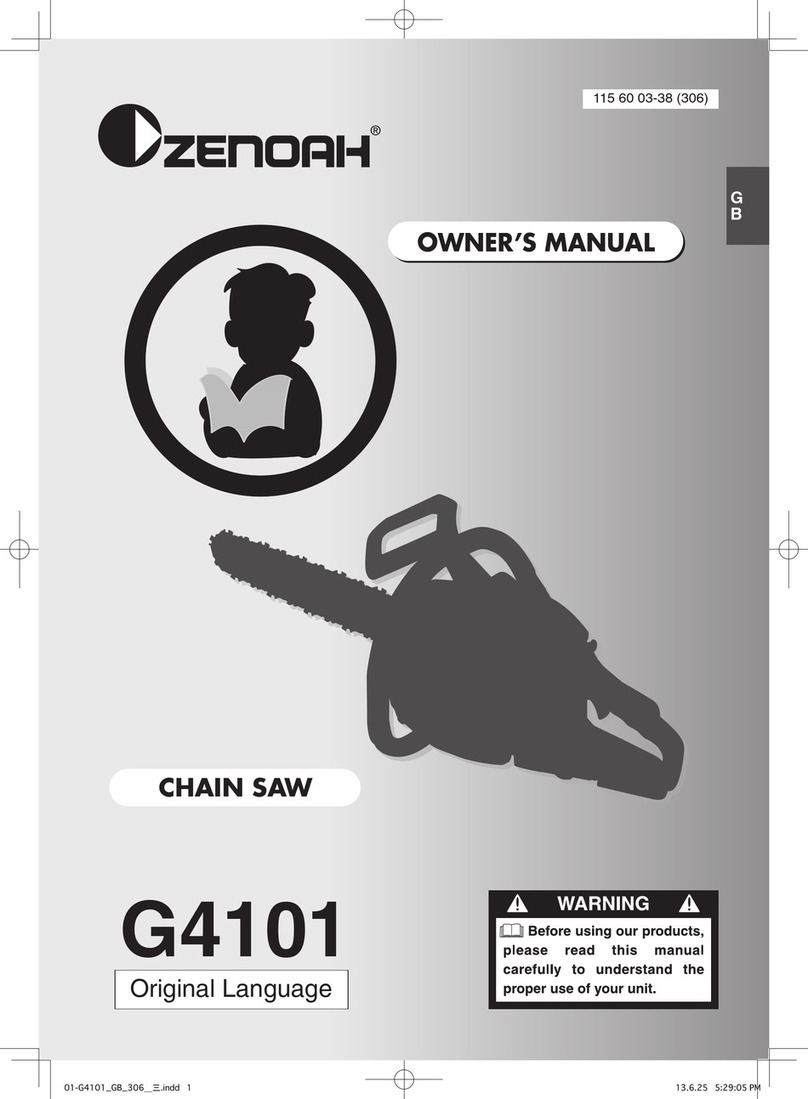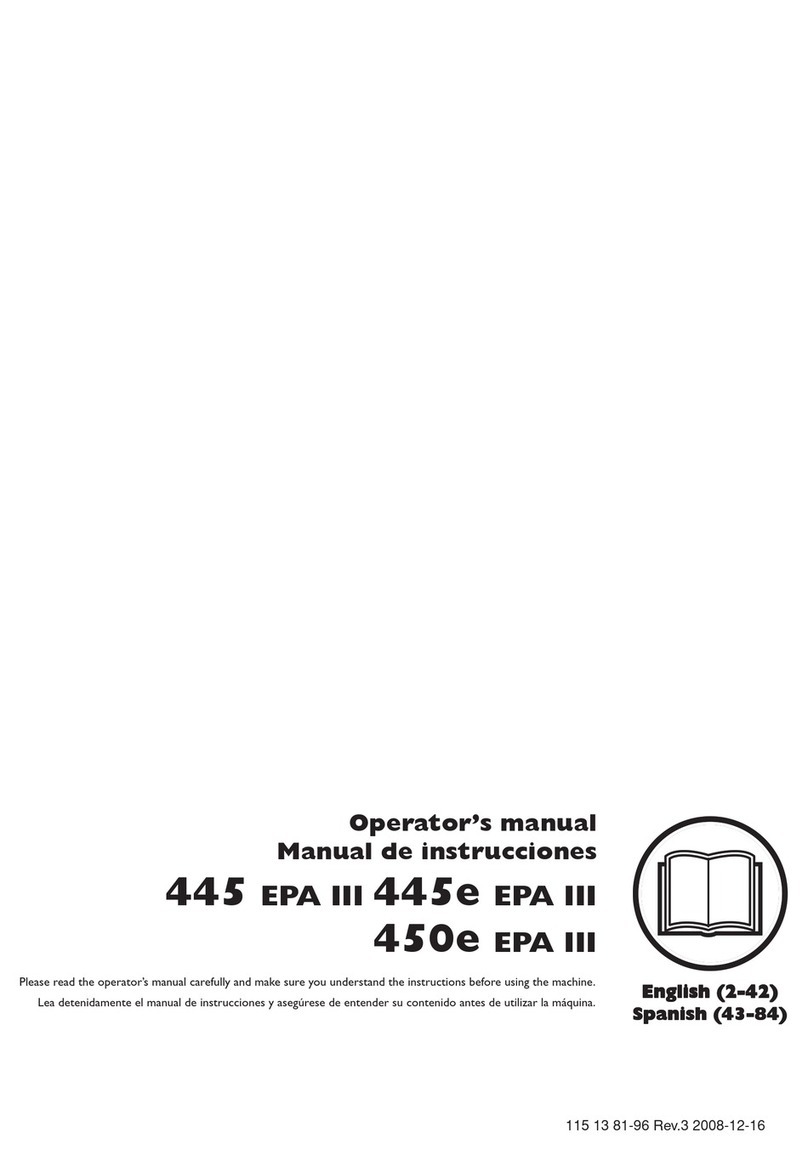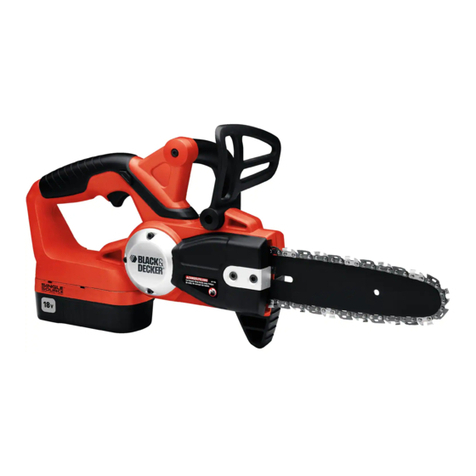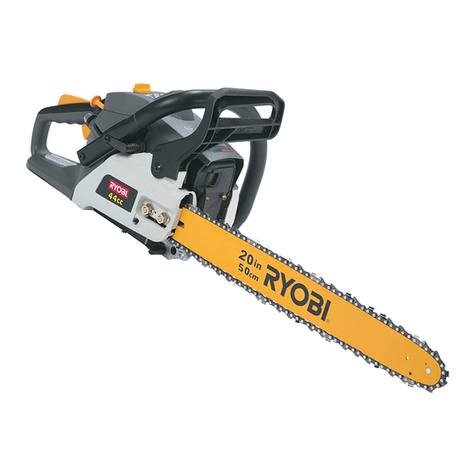bonomi MITO QTH12 User manual

·
·
·









—
-
-
-
-
-
-
-
-
-





Hydraulics
Mito
QTH12 English
15
Your MITO Hydraulics chainsaw is a power tool designed to perform straight cuts into
concrete, reinforced concrete, stone, using the proper diamond chain and bar. The
product needs sufficient clean water to operate and cool bar and chain through the water
inlet system. Powerful and lightweight, this product is designed to perform finishing jobs
by professional cutters and any kind of contractors. Follow general contractor, local and
national regulations how to dispose of slurry generated during operating the saw.
Operator needs to be properly trained.
Do not use this product to cut wood, plastic or other materials not listed above.
Do not use bars and chains different from the ones defined in this user manual.
In the following text, figures are identified by numbers,
details inside figures by letters. Figures are depicted on the
first pages of this user manual.
A safety message alerts you to potential hazards which
could injure you or others or cause property damage. The
safety messages or signal words for product safety signs
are DANGER, WARNING and CAUTION. Each safety
message is proceeded by a safety alert symbol and is
defined as follow:
- DANGER: indicates an imminently hazardous
situation which, if not avoided, will cause death or
serious injury. This safety message is limited to the
most extreme situations
- WARNING: Indicate a potentially hazardous
situation which, is not avoided, could result in
death or serious injury.
- CAUTION: Indicates a potentially hazardous
situation which, if not avoided, may result in minor
or moderate injury. It may also be used to alert
against unsafe practices that may result in
property-damage-only accident
In this manual all of them, DANGER, WARNING and
CAUTION are marked with the symbol
1) G
Ge
en
ne
er
ra
al
l
s
sa
af
fe
et
ty
y
r
ru
ul
le
es
s
WARNING! Read all instructions. Failure to follow all
instructions listed below may result in electric shock, fire
and/or serious injury. The term "power tool" in all of the
warnings listed below refers to your mains operated (corded)
power tool or battery operated (cordless) power tool.
SAVE THESE INSTRUCTIONS
1) Work area: CAUTION
a) Keep working area clean and well lit. Cluttered
and dark areas invite accidents.
b) Do not operate power tools in explosive
atmospheres, such as in the presence of
flammable liquids, gases or dust. Power tools
create sparks which may ignite the dust or fumes.
c) Keep children and bystanders away while
operating a power tool. Distractions can cause
you to lose control.
2) Personal safety. CAUTION
a) Stay alert, watch what you are doing and use
common sense when operating a power tool. Do
not use a power tool while you are tired or under
the influence of drugs, alcohol or medication. A
moment of inattention while operating power tools
may result in serious personal injury.
b) Use safety gear: always wear eye protection.
Safety equipment such as dust mask, non-skid safety
shoes, gloves, hard hat, or hearing protection used
for appropriate conditions will reduce personal
injuries.
c) Avoid accidental starting. Ensure the switch is in
the off position before plugging in. Carrying power
tools with your finger on the switch or plugging in
power tools that have the switch on invites accidents.
d) Remove any adjusting key or wrench before
turning the power tool on. A wrench or a key left
attached to a rotating part of the power tool may
result in personal injury.
e) Do not overreach. Keep proper footing and
balance at all times. This enables better control of
the power tool in unexpected situations.
f) Dress properly. Do not wear loose clothing or
jewellery. Keep your hair, clothing and gloves
away from moving parts. Loose clothes, jewellery
and long hair can be caught in moving parts.
g) If devices are provided for the connection of dust
extraction and collection facilities, ensure these
are connected and properly used. Use of these
devices can reduce dust related hazards.
d) Use auxiliary handles supplied with the tool. Loss
of control can cause personal injury.
3) Power tool use and care. WARNING
a) Do not force the power tool. Use the correct
power tool for your application. The correct power
tool will do the job better and safer at the rate for
which it was designed.
b) Do not use the power tool if the switch does not
turn it on and off. Any power tool that cannot be
controlled with the switch is dangerous and must be
repaired.
c) Store idle power tools out of the reach of children
and do not allow persons unfamiliar with the
power tool or these instructions to operate the
power tool. Power tools are dangerous in the hands
of untrained users.

Hydraulics
Mito
QTH 12
English
16
d) Maintain power tools. Check for misalignment or
binding of moving parts, breakage of parts and
any other condition that may affect the power
tools operation. lf damaged, have the power tool
repaired before use. Many accidents are caused by
poorly maintained power tools.
e) Keep cutting tools sharp and clean. Properly
maintained cutting tools with sharp cutting edges are
less likely to >>>> and are easier to control.
f) Use the power tool, accessories and tools etc., in
accordance with these instructions and in the
manner intended for the particular type of power
tool, taking into account the working conditions
and the work to be performed. Use of the power
tool for operations different from intended could
result in a hazardous situation.
5) Service
e) Have your power tool serviced by a qualified
repair person using only identical replacement
parts. This will ensure that the safety of the power
tool is maintained.
2
2)
)
S
Sa
af
fe
et
ty
y
r
ru
ul
le
es
s
f
fo
or
r
y
yo
ou
ur
r
c
ch
ha
ai
in
ns
sa
aw
w
2.1) Water supply: Safety rules
In order to run properly, the chain needs to be
cooled by water.
2.4) Checks and precautions to avoid structural
damage and damage to a building
2.2) Checks and precautions to avoid structural damage
and damage to a building. DANGER
Before operating, talk to the construction manager or the
planner in order to make sure that cutting doesn’t:
damage the structure of the building and change
the structural characteristics of the construction;
damage any water or gas pipeline or any electric
mains.
DANGER Particularly care if presence of gas
pipeline, cutting iron sparks is present and can be a
comburent for the gas
2.3) Checks and precautions to avoid damage caused
by the fall of the cut out work piece. DANGER
before operating, make sure that the possible falling
of the cut out work piece doesn't make any
damage. In any case, secure the area where the
work piece can fall and signal the danger;
if the possible fall of the cut out work piece can
damage anybody or anything, make sure to have a
proper system in place to secure it safely.
2.4) Fastening the work piece and size of the work piece
if you are operating on a block not part of a
structure, fasten it in order to prevent its movement.
Prevent the work piece from shifting, moving or
falling when you are cutting.
2.5) Suitable Bars and Chians
Use bars and chains for wet cutting. Bars and chain
for concrete, reinforced concrete, stone, are
suitable for your product. Your product is not
suitable to cut wood, plastics, metals (except
reinforcing bars in concrete).
Use only bars and chains provided by BONOMI
or authorized dealer.
2.6) Bars and Chains not to be used
Do not use bars and chains other than the ones
prescribed by BONOMI. Do not use chains for
wood, tungsten carbide chains or chains for
masonry. Chains for wood or masonry generate a
kickback effect when plunging.
2.7) Protective devices
Before operating make sure to wear all safety devices listed
below:
Always
wear safety
goggles
Always
wear safety
gloves
Always
wear ear
protection
Always
wear safety
shoes
2.8) Other safety directions. WARNING
Keep handles (pointed with H and F in figures)
dry and clean. Make sure there is no oil or
grease on them. Greasy or wet handles can lead
to lose control of the chainsaw.
Make sure to firmly grip the product using both
hands on handles (fig. 5). Firmly hold the product
with both hands till the chain has come to a
complete stop.
When storing or transporting the product make
sure the protecting cover (not present) is on the
bar (B) and chain (A).
When operating, keep proper footing and
balance for a full control of the product.
Improper footing and balance, operating on ladders
or on unstable structure can lead to serious injury
or death.
When operating do not excessive stretch out
your arms and do not perform cut higher than
your shoulders. Arms stretched too far out or cuts
above shoulder height can lead to loss of control of
the chainsaw.
Keep the chain sharp (see “Operating tips”
paragraph).
A not dull chain leads to an excessive feed by the
operator and this can lead to lose control of the
product.
Do not use the product if the cover (D), the front
panel (G), the slurry protector (I) or any other
protection devices is damaged or not properly
working. Those devices prevent to get in contact
with moving parts and to protect the operator from
slurry and debris.
Do not use the product if chain, main sprocket
and/or bar are damaged.
When performing vertical cuts, do not operate
using the product upside down (fig. 18). Water
and debris can hit the operator and can wrongly
flow over the product leading to a possible danger.
For this reason do not perform overhead cuts!!!
Do not place the bar and chain in a previously
made cut performed with a narrower chain (less
than 6 mm). This can lead to a kickback.
Do not force the bar, during cutting, to torsion
effort

Hydraulics
Mito
QTH12 English
17
Do not force the bar, during cutting, to bending
effort
3
3)
)
C
Ch
he
ec
ck
ks
s
b
be
ef
fo
or
re
e
o
op
pe
er
ra
at
ti
in
ng
g
3.1) Connection to a water supply
The chainsaw is equipped with a water inlet system (figure
8. Connect the chainsaw to a water supply using this system
following those steps:
Connect the water hose (O) to the quick hose
connector (P); Not present
Make sure there is no water leakage;
the maximum pressure of incoming water is 4 bar
(58 PSI);
use just clean water;
4
4)
)
B
Ba
ar
r,
,
c
ch
ha
ai
in
n
a
an
nd
d
S
Sp
pr
ro
oc
ck
ke
et
t
4.1) How to use the bar
the bar (B) needs to be periodically flipped over in
order to wear out eavenly on both sides;
the bar wears out. Usually you need to replace it
every 2 to 3 times you replace a chain;
a correct chain (A) tension allows a longer bar life. See
paragraph 4.2 and image U,V,Z page 10
4.2) How to use the chain. WARNING
Chains usage lead to chain stretching;
An optimal chain tension reduces chain and bar
wear and increases productivity and safety.
Check chain tension before use and stop
periodically during operation to make sure the chain
tension is correct;
An excessive tension leads to higher friction,
reducing cutting performance and increasing bar
and chain wearing;
A loose chain reduces cutting performance and can
lead to the chain to disengage from the bar;
Follow steps in paragraph 4.3) Mounting and
replacing bar and chain to set the correct chain
tension; see also movie on:
https://www.youtube.com/watch?v=pX1tBLgFTQU&
t=4s
Check the chain more frequently when the chain is
new since new chains have higher chain stretching.
your hydraulic chainsaw machine is equipped with
a rapid tensioning system called Quick Tensioning
which greatly facilitates the chain tensioning
manoeuvres and thanks to this the chain can work
with the correct tension without the aid of
particularly complicated mechanical manoeuvres,
simply by operating the knob shown in figure 1, T
Pay close attention to the use of this easy and
immediate tensioning system and perform tension
tests before cutting in order to get used to the
tension system
Never perform the tension by turning the knob
shown in figure 1, T during the cutting
The tensioning of the chain must be carried out with
the guide bar pulled out of the cut and with the
chain stopped. Once the ideal tension has been
reached, as described in the following point 4.3
activate the hydraulic saw motion to check if the
tension reached is maintained. If the tension is
optimal, as described in point 4.3, you can continue
with the cutting operations.
The correct maneuver is: Remove the guide bar
from the cut, stop the engine visually check the
conditions of extension of the chain with respect to
the guide bar, (the correct chain tension is shown in
figures U, V, Z in page 10) operate, if necessary,
the tensioning operation of the chain by acting on
the knob of fig. 1, T.
Since the operation is very simple, it is
recommended to avoid the over tension of the
chain, the excessive tension of the chain is not
recommended before starting the cut and can
reduce the chain life
The equipment allows tensioning and give up the
chain with a simple screwing or unscrewing
operation of the indicated knob, it is therefore the
operator's responsibility to realize that
excessive tension can cause damage to the
equipment as well as to people and damage the
chain by cracking.
We invite any operators to take good knowledge of
the use of this easy system that on the one hand is
very effective in terms of operator fatigue and
cutting times on the other hand if used with abuse
can induce the chain to work in conditions of
overload and permanently damaging it, thus
creating a dangerous condition.
4.3) Mounting and replacing bar and chain
Before mounting or replacing the bar (B) or the
chain (A) make sure the chainsaw is unplugged (M)
and the power pack is switch off. Do this operation
in a safe place, use protective gloves and place the
product on a stable surface.
Installing Chain (A) See figure 10, page 10, 1, and follow
these steps: or link to the movie
https://www.youtube.com/watch?v=pX1tBLgFTQU&t=4s
1. Unscrew and remove the 2 side cover screw (11/A)
2. Remove the cover (11/B);
3. loosen the 11/A nut on the back of the machine the guide
bar will be released and can slide back and forth and is
free to change,
4. Using the, T tension knob. Return the sprocket to the
initial position from 11C to11C1, page 7
5. Positioning the guide bar towards the sprocket 10/D in
order to create the necessary space for inserting the
chain,
6. Easily extract the old chain,
7. Insert the new chain on the guide bar 10/A and wind the
chain around the 10/B guide bar head bearing, to have
the chain saving at the back of the sprocket 10/G,
8. Install the chain on the sprocket proper position 10/C,
please note the reverse chain made specifically for this
machine has a sense of cutting, see fig Y page 10, make
sure not to install the chain in the opposite direction,
9. If you install the chain in the wrong direction
compromises the functionality of the same as well as
damage it irreparably,
10. Repeat reverse step from point 4.3 to 4.1 to fix not
permanently the cover.
11. Pull the guide bar by positioning the chain in a manual
tension position, see page 8, Fig.10G to 10H and than
Screw and fix the 2 nut 11/A on the back of the machine
body and secure the guide bar to the machine body fig
10/I

Hydraulics
Mito
QTH 12
English
18
12. Operate with the knob, T as indicated in 10/L and tension
the chain respecting the indications given in the previous
point 4.2
13. Position the closing cover 10/M, 10/N, 10/O and tighten
it with the 10P screw,
4.4 Installing Guide Bar (B) see figure 11, page 7, and
follow these steps.
1. Unscrew the 2 front screw and the nut 11/A on the
back of the machine, remouve the cover. The guide bar
will be released and removable 11/D
2. Using the tension knob, T bring the sprocket back to its
initial position as shown in fig (11/C1 to 11/C on page
7)
3. Replace the new bar by positioning it in the
predetermined position of the machine body itself fig.
11/D
4. reposition the Cover and temporarily tighten the nut on
the back, 11/A making sure that the position of the bar
is adequate to insert also the new chain
5. Proceed with the greasing of the machine using the
special greasers on the back of the machine fig 12/D
6. continue the positioning and tensioning operations of
the chain as indicated in the previous points
7. See page 13 for bar maintenance, control the correct
movement of the head bearing and use pressure
bearing grease to increase the life of the bar.
4.4) Mounting and replacing the sprocket
The back main sprocket wears out and needs to be
periodically replaced; replacement takes place usually every
2 to 3 chain replacements. See figure 12:
DANGER: Before starting, make sure the
chainsaw is unplugged from the power
source(M).
Make sure to be in a safe place when performing
this operation. Place the chainsaw on a stable
surface;
unscrew and remove the side cover screw (11/A);
remove the side cover of the machine fig 6 page 5
Remove the retaining spring fig 12/A page 9 and
remove the damaged sprocket (12/C);
Clean the housing area of the shaft, leaving a veil
of oil,
Replace the old sprocket
Proceed backwards by fitting the new sprocket, the
retainng spring, as shown in figure 12/A
Proceed accordingly with the operations described
previously of replacing the chain and or the guide
bar.
5
5)
)
O
Op
pe
er
ra
at
ti
in
ng
g
i
in
ns
st
tr
ru
uc
ct
ti
io
on
ns
s
5.1) Follow those steps:
To perform a cut, after having carefully read the paragraphs
above and having checked grounding:
with unplugged chainsaw, make sure the chain is
correctly tightened;
connect the hydraulic chainsaw at the power-pack
hose with the 2 jack P1 an P2;
Turn on the valve (O) letting water in your MITO
machine will inflate the water in the bar and on the
chain pushing the command handle (fig 3 – N) this
handle is pushed automatically from your hand,
when you will start to run the chainsaw pulling the
second command handle (fig 4 O);
Firmly hold the saw with both hands as shown in
figure 5;
Make sure the chain is not in contact with anything
and then switch on the saw (N). In order to avoid an
unintentional start, the switch is equipped with a
lock off system. This means that you need to follow
two steps (N and O) to switch on the chainsaw as
shown in figure 3 and 4;
5.2) Cutting methods
Lay out the cut with a marker: the cut must be
straight;
To start, plunge the nose of the cutting bar straight
into material till you reach the desired cutting depth.
Keep the bar perpendicular to the wall;
Rock the saw when cutting (figure 15). This leads to
leverage effect that makes cutting easier.
Do not apply too much feed force. A good feed
force leads to best cutting performance, excessive
feed force leads to lower RPM and lower
performance;
Do not perform non-straight cuts and do not tilt side
by side the chainsaw: these would lead to motor
overload and damage bar and chains;
To stop, release the switch (N);
Warning: the chain keeps running for some
seconds after the switch has been released;
Close the water valve (O);
5.3) Horizontal cuts
You can perform either horizontal or vertical cuts.
When cutting horizontally make sure the work piece
does not press on the bar: use the product as
shown in figure 17. Do not use the product with
handle downward as shown in figure 16. When
cutting an opening such as a window perform first
horizontal cuts and then vertical ones.
5.4) Cutting reinforced concrete
When cutting reinforced concrete rock the saw as
shown in figure 15 in order to keep cutting concrete.
This avoids that the segments gets polished
reducing cutting effectiveness;
Cutting rebar only is not allowed and sure you
compromise the chain functionality and his integrity
up to braking it.
5.5) Re-Sharpening the segments after cutting still bar
for a long time
If you experience reduced cutting effectiveness for
polished segments, re-sharpen the segments using
a sharpening stone (not included). Make sure the
stone is properly fastened: see stone manufacturer
directions. Perform re-sharpening with water,
cutting a 1" cut in the sharpening stone.

Hydraulics
Mito
QTH12 English
19
Warning: do not perform re-sharpening holding the
stone by hand or your feet.
6
6)
)
M
Ma
ai
in
nt
te
en
na
an
nc
ce
e
–
–
S
Se
er
rv
vi
ic
ce
e
-
-
W
Wa
ar
rr
ra
an
nt
ty
y
6.1) Cleaning, maintenance and lubricating
At the end of the working day, perform the following
operations:
Warning: do not clean you chainsaw with water
jets or high pressure cleaner too many pressure
can damage the machine;
Warning: remove bar and chain before proceeding
with the following operations.
Blow compressed air on the motor, in order to
remove slurry. Use protective goggles when doing
it.
DANGER: unplug from power source the chainsaw
before proceeding with the following operations.
Check the hydraulic connector to the hose and
control if are well operating, if not should be
changed, ask to your dealer
With bar and chain off and after having
disassembled the cover, remove the slurry from the
chainsaw and add grease (11/M)
Oil the chain tensioning system;
spray, rotating the guide bar head bearing, with the
suggested spray grease as shown in fig 13/A, 13/B,
13/C pag.13
Dry bar and chain;
Oil bar and chain;
keep your product clean and dry, in particular its
handles;
never use solvents or other harsh chemicals to
clean your product;
gears are lubricated by lubricating oil and grease
which are suited for any external temperature. You
don’t have to check the oil level or to fill it up.
after use put your saw in a dry, safe and
inaccessible place to children place.
6.2) Service
Some components of your chain saw wear. It
depends on how long you used the product and
how heavy was the work. Bring your product to an
authorized Bonomi service center for a check after
6 months if heavily used or every year if regularly
used. Wearing parts are: bar, chain, back sprocket,
brushes, rotor, power hoses, switch, sealing rings,
bearings, and lubricants.
any repairs must be carried out by Bonomi
authorized service personnel only. Ask your dealer
for the list of the Bonomi authorized service
centers.
We suggest to Use original Bonomi parts only.
your core product serial number is stamped on the
machine or printed on the data plate as shown in
figure 7
No components of your Bonomi product (except
bar, chain and back sprocket) can be replaced by
the user. Replacement must be carried out by
Bonomi authorized personnel only.
Bonomi Service Centers: Ask your dealer for a
BonomiI service centers address list.
6.3) Bonomi Warranty – 12 months
According to current European Directives, the manufacturer
must provide a 12 month warranty on the product. Some
countries may vary. Check with your local Distributor.
If your chainsaw is not functioning properly or has faulty
workmanship or flaws in material within 12 months from the
date of purchase Bonomi will replace, free of charge for the
owner, defective components or, at Bonomi discretion, the
whole product, if:
The product has been purchased within 12 months:
invoice or delivery certificates are needed to prove
this;
The product has not been misused. The product
must have been used properly according to the
directions provided in this user manual;
no unauthorized people have operated on the
product;
This warranty does not apply if malfunctioning is caused by
worn out parts.
7
7)
)
O
Op
pe
er
ra
at
to
or
rs
s
T
Tr
ra
ai
in
ni
in
ng
g
The product is easy to use, however a brief training allows
better safety and performance.
Bonomi and some authorized distributors provide, free of
charge, training sessions at their locations.
8
8)
)
P
Pa
ac
ck
ka
ag
ge
e
C
Co
on
nt
te
en
nt
ts
s
The chainsaw package includes, wrench and:
User Manual.
Wrench
Documents: Data sheet, Exploded view drawing and
spare parts list.

Hydraulics
Mito
QTH 12
English
20
Save these instructions for future consultation
Products to the end of their life.
The symbol on the left, that you can find on the product or on its packaging indicates that this product may not be treated as
household waste. At the end of its life the products must be handed over to the applicable collection point for the recycling of
electrical and electronic equipment.
Be sure that this product is disposed correctly. You will help prevent potential negative consequences for the environment and
human health. For more detailed information about what to do when your product doesn't work and is not fixable, contact the dealer
where you did purchase the product.
Your product has been introduced new on the market after August 13th 2005.
This manual is subject to modifications without notice.
WARNING:
THE MANUFACTURER DECLINES ALL RESPONSABILITY
IN CASE OF NO RESPECT OF THE ABOVE WRITTEN
"SAFETY AND OPERATING INSTRUCTIONS".
This manual suits for next models
1
Other bonomi Chainsaw manuals



